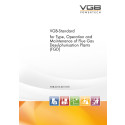By 1970 plants for the reduction of dust emissions had been state of the art worldwide, following this the first tests to reduce emissions of sulphur dioxide, SO2, and nitrogen oxides, NOx, were carried out in Germany. By the late seventies, the first large-scale plants for desulphurisation of flue gases were built. In the eighties in Europe, legal requirements concerning SO2 and NOx reduction were implemented on a national basis. These technologies had been previously employed in other countries (especially Japan) when new plants were constructed as a consequence of the increasing smog problems in conurbations. The production of such plants experienced its first boom in 1983 in Germany, soon to be followed by Austria, when retrofitting of existing plants was demanded by law. In this period, oil prices were high and coal-fired power plants equipped with flue gas desulphurisation plants (FGD) could survive competition. However, prices began falling during the period of retrofitting the coal-fired power plants in Germany and Austria with FGD, from about 1987. The other EU member states consequently had economic reservations about retrofitting existing plants so that retrofitting was only demanded for new plants.
The European directives on ambient air quality of 1997 implemented further goals of the World Health Organisation (WHO). After 2001, retrofitting of existing plants has become an EU-wide obligation so that now a second FGD boom can be observed. Thanks to further state of the art developments, stricter limit values could be introduced for new plants. Today, international power plant projects in developing countries and emerging industrial countries that want to obtain promotional funds from the World Bank are examined with respect to whether planning complies with the demand for environmental protection measures according to “best available technique” (BAT). In the future, an international state of the art will have to be observed for every new plant. Due to the increasing interchange of products from different regions, environmental dumping will thus be avoided. These techniques comprise more than 30 years of process development reflected through practical experience. They are described in this instruction sheet. This instruction sheet was edited by the VGB “FGD Instruction Sheet” project group of the VGB “Flue Gas Cleaning Technology” working panel to support employees of VGB member companies in achieving an economic operation and maintenance measures of FGD. The instruction sheet is furthermore intended to record experience gathered over the past years. This is the only way to avoid that the “wheel”, i. e. FGD, is reinvented over and over again.
Dieser vgbe-Standard liegt nur in Englischer Sprache vor./This vgbe-Standard is only available in English.

